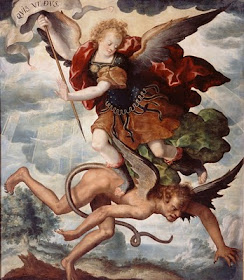By Jack Doyle, 7th December 2010
Hundreds of criminals are to be given four days a year off prison work - to celebrate pagan festivals. Prison governors have been issued with a list of eight annual pagan holidays and told pagan inmates can choose four to celebrate.
The festivals include Imbolc - The Festival of the Lactating Sheep - which falls on February 1 and is dedicated to the goddess Brighid. Another is the festival of Beltane, which falls in early May, devotees are urged to celebrate the Sun God with 'unabashed sexuality and promiscuity'.
The Yule festival involves pagans 'casting spells' and dressing up as ghosts.
Pagan inmates may even be allowed special food and drink on their days off. Traditional pagan food include Ewe's milk for Imbolc, Simnel Cake and eggs on Spring Equinox and Roast Goose on Autumn Equinox.
On Samhain - celebrated on Halloween - pagans by tradition go apple bobbing.
It is the latest in a series of rulings to protect convicts' rights and ensure equality among different faiths.New guidelines entitled 'Religious Festival dates for 2011' state that all prison staff must be made aware of the pagan festival dates. It states: "The Prison Service is committed to ensuring that prisoners from all religious faiths are given the opportunity and facilities to practise their religions.'"
It lists the eight main festivals before adding: "Most Pagans celebrate the eight festivals set out, but depending on the particular tradition would attach particular significance to certain days."
"Because of variations in emphasis between different Pagan traditions it has been agreed with the Pagan Federation that prisoners may choose four festivals on which they should not be required to work."
Prisons are told they must prepare specific foods if it is a requirement of a prisoner's religion. But the guidance states the food should be prepared inside prison kitchens and the cost must be 'proportionate to the number of prisoners involved'.
Paganism was first recognised by the Prison Service as a religion more than nine years ago. The number of prisoners declaring themselves as pagan has tripled in six years to 366 last year. Worshippers are allowed to keep tarot cards, a hoodless robe and a twig to use as a wand in their cell. They can also keep incense, a piece of jewellery and rune stones. Skyclad, or naked worship, is banned.
Pagan inmate Mark Stewart, who is serving a three year term for drug dealing at HMP Elmley in Kent, wrote to prisoners' newspaper Inside Time this month to complain about how Pagans are treated. He claimed Pagans had been 'sidelined' and 'marginalised' in favour of more popular religions. He wrote: "There is a perception amongst most people that Pagans are devil worshippers, etc, but that is so far from the truth."
"I am an earth loving person who thanks Mother Earth, spirits and ancestors for what I have today. I do practise witchcraft, but only for good."
Sources said there was 'no question' of prisoners being served roast goose or boar. A Prison Service spokesman said: "The Prison Service issues annually a list of religious festival dates for the year ahead – this includes key dates on which prisoners registered in that affiliation can be excused from work."
It comes a day after it emerged that an underworld crime boss jailed for the murder of two grandparents has won the right to be called 'Mr' by prison guards. Colin Gunn complained that he was not treated with sufficient respect and, under guidelines introduced by Labour, prison officers are required to address inmates as they wish.
Pagan inmate Mark Stewart, who is serving a three year term for drug dealing at HMP Elmley in Kent, wrote to prisoners' newspaper Inside Time this month to complain about how Pagans are treated. He claimed Pagans had been 'sidelined' and 'marginalised' in favour of more popular religions. He wrote: "There is a perception amongst most people that Pagans are devil worshippers, etc, but that is so far from the truth."
"I am an earth loving person who thanks Mother Earth, spirits and ancestors for what I have today. I do practise witchcraft, but only for good."
Sources said there was 'no question' of prisoners being served roast goose or boar. A Prison Service spokesman said: "The Prison Service issues annually a list of religious festival dates for the year ahead – this includes key dates on which prisoners registered in that affiliation can be excused from work."
It comes a day after it emerged that an underworld crime boss jailed for the murder of two grandparents has won the right to be called 'Mr' by prison guards. Colin Gunn complained that he was not treated with sufficient respect and, under guidelines introduced by Labour, prison officers are required to address inmates as they wish.


























